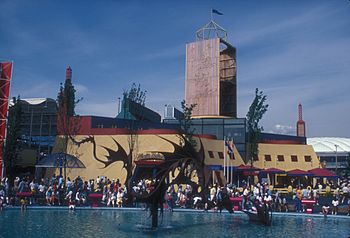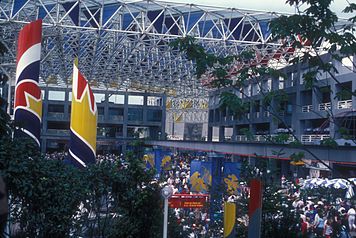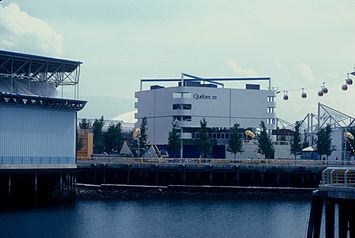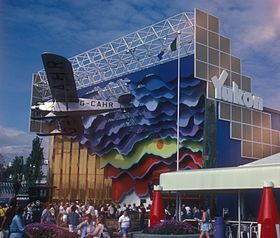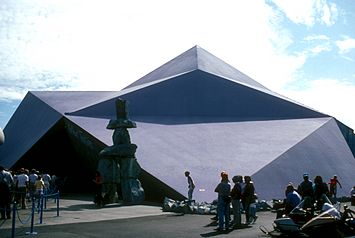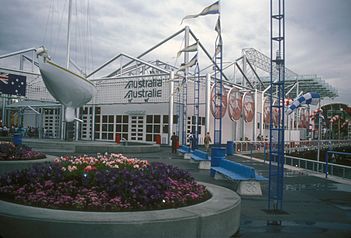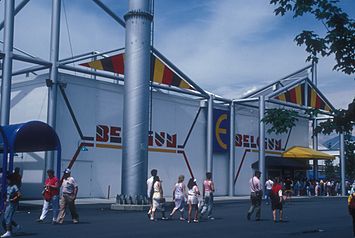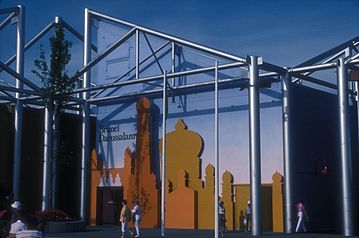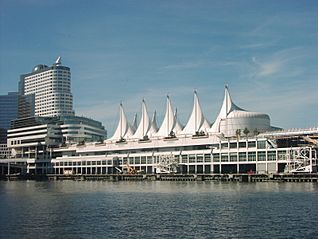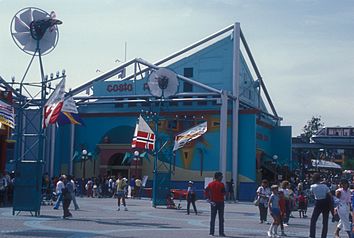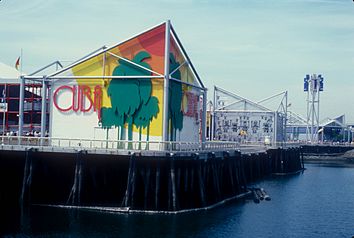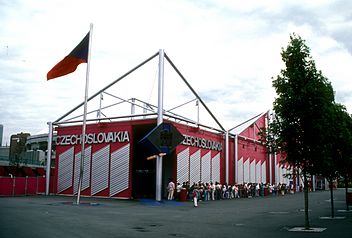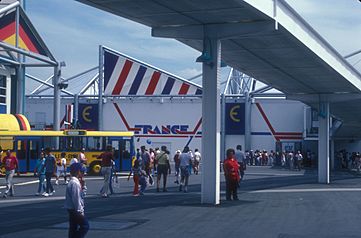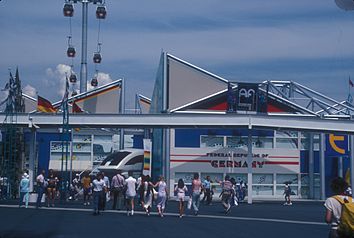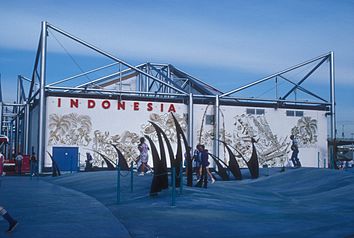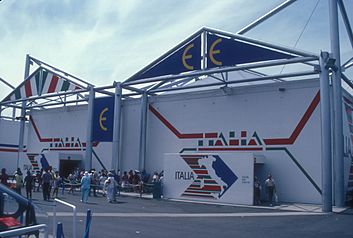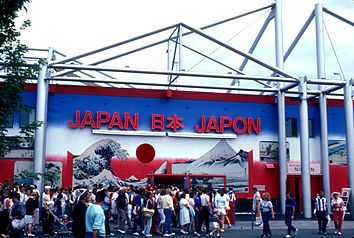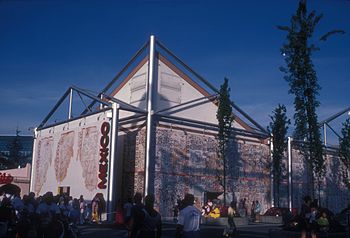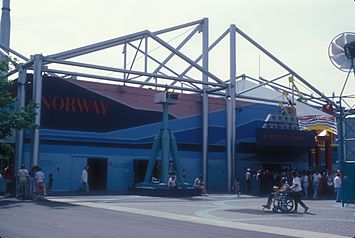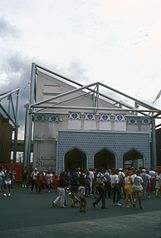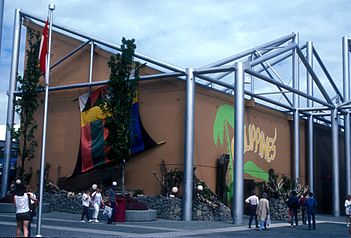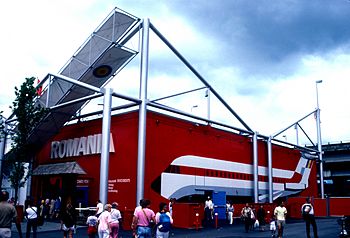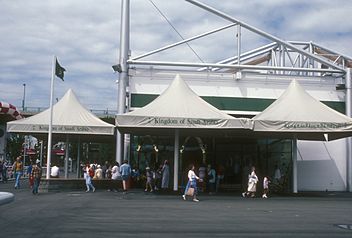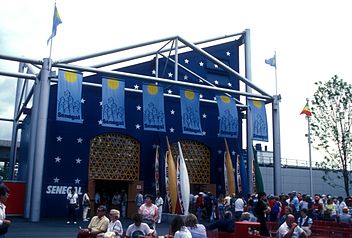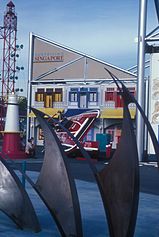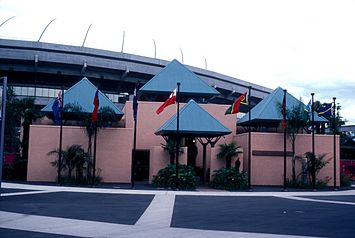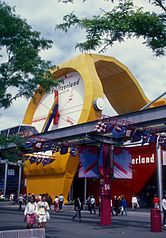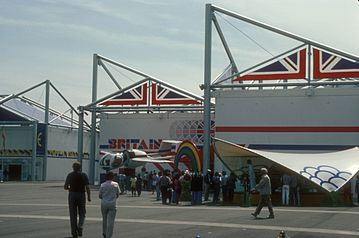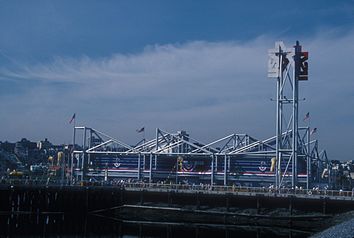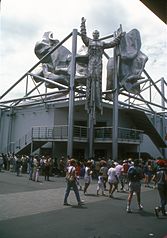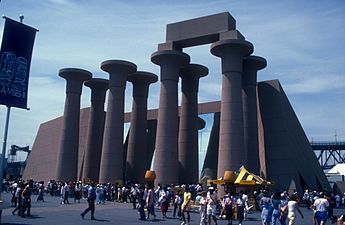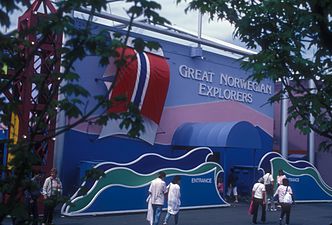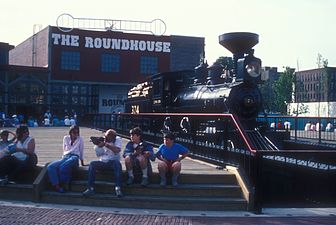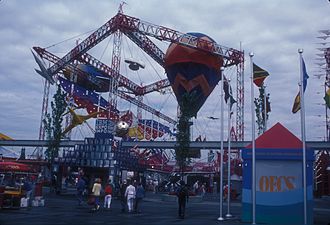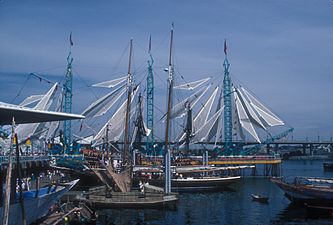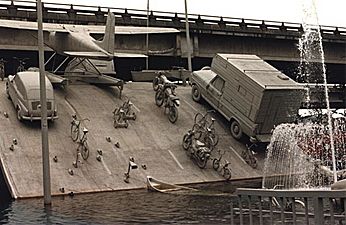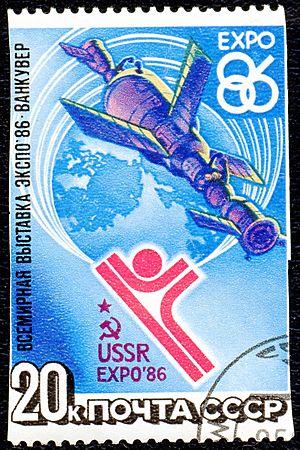Expo 86 facts for kids
Quick facts for kids 1986 Vancouver |
|
|---|---|
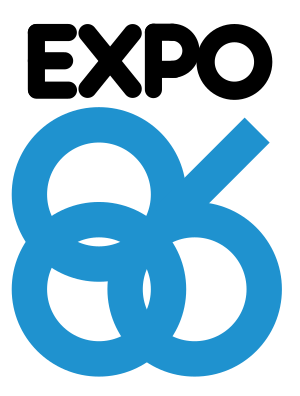
The Expo 86 logo
|
|
| Overview | |
| BIE-class | Specialized exposition |
| Category | International specialized exposition |
| Name | 1986 World Exposition on Transportation and Communication |
| Motto | "World in Motion – World in Touch" |
| Building | BC Place Stadium, Canada Place, Science World (Vancouver), SkyTrain |
| Area | 70 hectares (170 acres) |
| Visitors | 22,111,578 |
| Mascot | Expo Ernie |
| Participant(s) | |
| Countries | 54 |
| Location | |
| Country | Canada |
| City | Vancouver |
| Venue | BC Place Stadium, Canada Place, Plaza of Nations, Expo Centre |
| Coordinates | 49°17′19.1″N 123°6′40″W / 49.288639°N 123.11111°W |
| Timeline | |
| Bidding | 1979 |
| Awarded | November 1980 |
| Opening | May 2, 1986 |
| Closure | October 13, 1986 |
| Specialized expositions | |
| Previous | Expo '85 in Tsukuba |
| Next | World Expo 88 in Brisbane |
| Universal expositions | |
| Previous | Expo '70 in Osaka |
| Next | Seville Expo '92 in Seville |
| Horticultural expositions | |
| Previous | International Garden Festival in Liverpool |
| Next | Expo '90 in Osaka |
The 1986 World Exposition on Transportation and Communication, often called Expo 86, was a big World's Fair held in Vancouver, British Columbia, Canada. It ran from May 2 to October 13, 1986. The main idea of the fair was "Transportation and Communication: World in Motion – World in Touch." It happened at the same time as Vancouver's 100th birthday.
This was the second time Canada hosted a World's Fair. The first was Expo 67 in Montreal. Expo 86 was a huge success! More than 22 million people visited it. This was twice as many visitors as the fair in Knoxville in 1982. It was also three times more than the fair in Louisiana in 1984.
Contents
What Was Expo 86 All About?
The logo for Expo 86 had three rings that looked like the number 86. These rings stood for the three main ways we travel: land, air, and water.
How Did Expo 86 Start?
Before Expo 86, the land where it was built was an old rail yard and industrial area. In 1978, a person named Sam Bawlf suggested having an exposition. It would celebrate Vancouver's 100th anniversary in 1986. The idea was first called "Transpo 86."
In 1980, the government passed a law to make the fair happen. The theme of transportation was chosen because Vancouver is a big port city. It connects Canada by rail and is a major travel hub.
The fair was first planned to be a small event. But it grew into a full World Exposition. This happened with the help of Patrick Reid, the Vancouver Exposition Commissioner-General. The theme of Transportation and Communication brought together many different exhibits.
Building the Fairgrounds
Construction for Expo 86 began in October 1983. Queen Elizabeth II, who was the Queen of Canada, helped start the work. She even started a concrete mixer! She also gave an "invitation to the world" to visit.
The fair was supposed to cost about $78 million Canadian dollars. But it ended up costing $802 million. This left a deficit of $311 million.
Changes for the City
As Vancouver got ready for many visitors, some people living in older hotels had to move. These were low-income residents in the Downtown Eastside. The city's mayor, Mike Harcourt, wanted to help them. But the provincial government did not change the laws to protect them.
What Happened at the Fair?
Expo 86 opened on May 2, 1986. Prince Charles and Diana, Princess of Wales opened the fair. Prime Minister Brian Mulroney was also there.
The fair had pavilions from 54 different countries. Many companies also had their own exhibits. Countries could design their own buildings. Or they could use simpler "Expo modules." These modules were about two-and-a-half stories tall. They could be put together in many shapes.
Expo 86 was a "Class II" or "specialized exhibition." This meant it focused on specific topics: transportation and communication.
Some pavilions had interesting timing issues. The United States pavilion focused on space travel. But this was just a few months after the Space Shuttle Challenger exploded. The U.S.S.R. (Soviet Union) pavilion celebrated its nuclear industry. But less than a week before the fair opened, the Chernobyl nuclear disaster happened.
What Could You See at Expo 86?
Canadian Pavilions
- Canadian provinces and territories
Many Canadian provinces and territories had their own pavilions. These included Alberta, British Columbia, Quebec, Yukon, and the Northwest Territories.
Countries and Organizations
- Countries and international organizations
-
Eastern Caribbean Nations
Many countries from around the world had pavilions. These included Australia, China, France, Japan, the United States, and the Soviet Union. The United Nations also had a pavilion.
Company Exhibits
Many companies had exhibits at Expo 86.
- BCTV set up a working TV studio. Visitors could see how TV shows and news were made.
- General Motors had a popular exhibit called Spirit Lodge. It used holograms and special effects.
- Canadian Pacific showed a film called Rainbow War. This film was later nominated for an Oscar!
Other Cool Exhibits
- The Great Hall of Ramses II from Egypt showed rare treasures.
- The Great Norwegian Explorers pavilion from Norway was also popular.
- The Roundhouse was an old railway roundhouse that was fixed up. A historic train, Engine 374, was displayed there.
- The Expo Centre later became Science World.
- Highway 86 was a unique outdoor sculpture. It was a concrete highway with cars and bikes painted grey and "frozen" in time.
- UFO H2O was a fun water playground for kids.
Who Visited and Performed?
Many famous people visited Expo 86.
- Royalty: Prince Charles and Diana, Princess of Wales were at the opening.
- Prime Ministers: Brian Mulroney (Canada) and Margaret Thatcher (United Kingdom) visited.
- Musicians: Many famous artists performed, including Harry Belafonte, Anne Murray, Miles Davis, Eurythmics, Julio Iglesias, Bryan Adams, Johnny Cash, Depeche Mode, The Beach Boys, and Roy Orbison.
- Comedians: Bill Cosby, Bob Newhart, and Bob Hope made people laugh.
- Other Guests: Oceanographer Jacques Cousteau also visited.
Quick Facts About Expo 86
- Official Theme: "Transportation and Communication"
- Sub Theme: "A Celebration of Ingenuity"
- Total Visitors: 22,111,578
- Dates: May 2, 1986, to October 13, 1986
- Chief Architect: Bruno Freschi
- Official Mascot: Expo Ernie – a robot
- Main Site Size: 165 acres (about 70 football fields!)
- Total Expo Site Size: 173 acres
- Participating Nations: 54 countries
What Happened After Expo 86?
Expo 86 was a huge success, even with a deficit. It helped change Vancouver from a smaller city into a well-known global city. It also greatly boosted tourism in British Columbia.
Today, the western part of the Expo site has become parks and tall apartment buildings. The eastern part is also being developed into parks and homes.
Lasting Parts of Expo 86
Some parts of Expo 86 are still in Vancouver today:
- SkyTrain – This is an automated train system. The first line was built to help people get to Expo. Now, it's a main part of Vancouver's public transport.
- Expo Centre – This building is now Science World. It's an interactive science museum with a giant OMNIMAX cinema.
- BC Place Stadium – This big stadium was used for the opening of Expo 86. It's now home to sports teams and hosts big events.
- Canada Place – This was the Canadian Government's pavilion. It's now a major convention center and cruise ship terminal.
- Plaza of Nations – This area was used for outdoor concerts. Some of its buildings are still there.
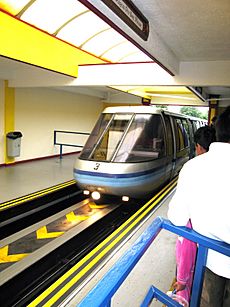
Many other attractions from Expo 86 were sold or moved:
- The Monorail – It's now at Alton Towers Theme Park in England.
- McBarge – This was a floating McDonald's restaurant. After the fair, it was left in the water for many years. It was moved in 2015 to be fixed up.
- Space Ship McDonald's – Parts of this restaurant were moved to Sechelt and rebuilt as a lighthouse on top of a pub.
- China Gate – This was a gift from the Chinese Government. It was moved to Vancouver's Chinatown.
- World's largest ice hockey stick – You can find this now in Duncan, British Columbia.
- Scream Machine roller coaster – This ride is now called Ninja at Six Flags St. Louis.
- Inukshuk – This stone sculpture was at the Northwest Territories Pavilion. It was moved to English Bay beach. It even inspired the logo for the 2010 Winter Olympics!
- Log Flume Ride – This water ride was moved to Upper Clements Parks in Nova Scotia.
Accidents at Expo 86
During the opening, Diana, Princess of Wales briefly fainted. Her husband, Prince Charles, said it was due to heat and being tired.
On May 9, 1986, a 9-year-old girl named Karen Ford died at the Canadian Pavilion. She was hurt on a moving platform that connected two parts of the pavilion. The platform was stopped for a while. Then it was put back into use with new safety features.
Expo 86 in Pop Culture
- The band Said the Whale wrote a song called "False Creek Change" about how Expo 86 changed the area.
- Death Cab for Cutie has a song called "Expo '86" on their album Transatlanticism.
- The band Wolf Parade also released an album named Expo 86 in 2010.
- Archie Comics even made a special comic book where the characters visited Expo 86.
Images for kids
-
The monorail at Expo 86. After the site closed, it was shipped to England where it was installed at the Alton Towers theme park in 1987.
See also
 In Spanish: Exposición Internacional de Vancouver (1986) para niños
In Spanish: Exposición Internacional de Vancouver (1986) para niños


